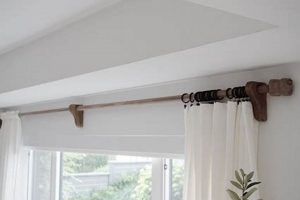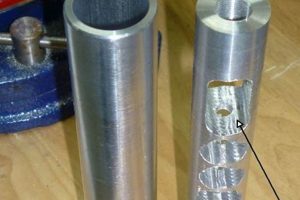A constructed light fixture, typically employing lightweight material formed from processed cellulose fibers, allows for the diffusion of illumination. An example is a handmade lampshade crafted from origami paper, placed over a bulb to soften and spread the light.
Creating personalized lighting solutions offers cost savings and creative expression. Historically, handcrafted lampshades provided an accessible means to enhance interior aesthetics. Modern applications prioritize customization and resourcefulness, enabling individuals to tailor lighting to specific needs and preferences.
The subsequent sections detail various methods, materials, and design considerations involved in crafting unique and functional lighting pieces. Exploration of these elements allows for a comprehensive understanding of the practical and artistic facets of this endeavor.
Tips for Crafting a Paper-Based Light Fixture
Achieving optimal results when constructing a paper-based light fixture requires careful planning and execution. The following guidelines enhance the safety, durability, and aesthetic appeal of the finished product.
Tip 1: Material Selection is Paramount: Opt for flame-retardant paper or apply a fire-retardant coating to standard paper. This reduces the risk of fire hazards associated with heat generated by the light source.
Tip 2: Frame Stability is Critical: Employ a robust frame constructed from wire, bamboo, or a similar sturdy material. This structural support prevents the paper from sagging or deforming over time.
Tip 3: Ventilation Must Be Adequate: Design the fixture with sufficient ventilation to dissipate heat. Ensure adequate airflow around the light bulb to prevent overheating and potential damage to the paper.
Tip 4: Bulb Selection Impacts Longevity: Utilize LED bulbs, which generate less heat compared to incandescent or halogen bulbs. This minimizes the risk of damaging or scorching the paper shade.
Tip 5: Secure Adhesion Enhances Durability: Employ acid-free adhesive specifically designed for paper crafts. This prevents discoloration and ensures a long-lasting bond between the paper and the frame.
Tip 6: Consider Light Diffusion Properties: Experiment with different paper types to achieve the desired light diffusion. Translucent papers create a soft, ambient glow, while thicker papers offer more focused illumination.
Tip 7: Protective Coating Extends Lifespan: Apply a sealant or varnish to the finished fixture to protect it from dust, moisture, and UV damage. This enhances the longevity and aesthetic appeal of the paper surface.
Adherence to these guidelines facilitates the creation of a safe, durable, and visually appealing paper-based light fixture. Careful consideration of these factors contributes to a successful and enduring project.
The following section addresses specific design techniques and creative embellishments to further personalize and enhance the visual impact of handcrafted lighting.
1. Material Flammability Mitigation
The potential for ignition and rapid fire spread necessitates rigorous attention to material flammability when constructing paper-based light fixtures. Effective mitigation strategies are paramount to ensure user safety and prevent property damage.
- Flame-Retardant Paper Selection
Utilizing paper specifically treated with flame-retardant chemicals reduces its susceptibility to ignition. This treatment inhibits combustion and slows the spread of flames, offering a critical layer of safety. Examples include paper impregnated with ammonium phosphate or borax. In the event of a malfunction or overheating bulb, flame-retardant paper minimizes the risk of a fire originating within the fixture.
- Application of Fire-Retardant Coatings
The application of specialized coatings provides an alternative approach to enhancing fire resistance. These coatings, typically applied as a spray or brush-on solution, form a protective barrier on the paper’s surface. Many commercially available coatings are designed to char and expand when exposed to heat, creating an insulating layer that slows combustion. This method allows for the use of decorative or specialized papers that may not inherently possess flame-retardant properties.
- Bulb Selection Considerations
The choice of light bulb directly influences the heat generated within the fixture. Incandescent and halogen bulbs produce significantly more heat than LED bulbs. Employing LED technology reduces the risk of overheating and ignition. Furthermore, selecting bulbs with appropriate wattage ratings prevents excessive heat buildup, contributing to a safer operating environment. It is imperative to adhere to the fixture’s maximum wattage recommendation.
- Ventilation Design Integration
Adequate ventilation facilitates the dissipation of heat, preventing localized temperature increases that could lead to ignition. Designs incorporating open areas or strategically placed vents allow for airflow around the bulb. Enclosed designs necessitate careful consideration of ventilation to ensure that heat does not accumulate within the fixture. Proper ventilation is a critical element in mitigating the risk of fire, particularly when using higher-wattage bulbs.
These flammability mitigation measures are not mutually exclusive and can be implemented in combination to provide a comprehensive safety strategy. The selection of appropriate materials, the application of fire-retardant coatings, the choice of low-heat bulbs, and the incorporation of effective ventilation design are all crucial elements in creating a safe and aesthetically pleasing paper-based light fixture.
2. Frame Structural Stability
The structural integrity of the supporting framework is a paramount consideration in the design and construction of paper-based light fixtures. Without adequate stability, the fixture risks deformation, collapse, and potential safety hazards, thereby undermining its functionality and aesthetic appeal. The frame serves as the foundational element upon which the paper shade is mounted, dictating its overall shape and resistance to external forces.
- Material Selection for Rigidity
The choice of material directly impacts the frame’s ability to withstand stress and maintain its form. Common materials include wire, bamboo, wood, and rigid plastics. Wire, while lightweight, may require reinforcement to prevent bending or distortion. Bamboo offers a balance of strength and flexibility, providing a natural aesthetic. Wood provides excellent rigidity but can be heavier and more challenging to shape. Rigid plastics offer durability and resistance to moisture but may lack the aesthetic appeal of natural materials. The selection
depends on the desired aesthetic, weight limitations, and the complexity of the design. - Joint Reinforcement Techniques
The points where frame components connect are particularly vulnerable to failure. Reinforcement techniques, such as soldering, welding, gluing, or mechanical fasteners (screws, rivets), are crucial for ensuring joint integrity. Soldering or welding provides a strong, permanent bond for metal frames. Glues specifically designed for the chosen material (e.g., wood glue for wood frames) offer a secure connection. Mechanical fasteners allow for disassembly and repair, providing flexibility but potentially compromising strength. Proper joint reinforcement is essential for distributing stress evenly throughout the frame, preventing localized failures.
- Geometric Design for Load Distribution
The geometric configuration of the frame influences its ability to distribute loads effectively. Triangular or geodesic structures inherently possess greater stability than square or rectangular configurations. Arches and curves can distribute compressive forces more efficiently than straight lines. The strategic placement of support members (e.g., cross braces, struts) enhances the frame’s resistance to bending and torsion. A well-designed geometric structure minimizes stress concentrations and maximizes the overall load-bearing capacity of the frame.
- Weight Distribution Considerations
The distribution of weight across the frame must be carefully considered to prevent imbalances that could lead to deformation or collapse. Asymmetrical designs require careful planning to ensure that the frame can support the uneven load. The weight of the paper shade, the light bulb, and any decorative elements must be factored into the design. Suspension points should be strategically located to distribute the load evenly and minimize stress on individual frame components. Proper weight distribution is critical for maintaining the stability and longevity of the fixture.
In summary, robust frame structural stability is integral to the successful creation and long-term performance of a paper-based light fixture. By carefully selecting materials, implementing effective joint reinforcement techniques, optimizing geometric design for load distribution, and considering weight distribution, a durable and aesthetically pleasing light fixture can be realized. Neglecting these aspects compromises the fixture’s integrity and increases the risk of failure, potentially leading to safety hazards. The stability of the frame directly correlates with the longevity and overall value of the lighting piece.
3. Ventilation Design Imperatives
Effective thermal management through strategic ventilation is critical for the safe and reliable operation of paper-based lighting assemblies. Inadequate dissipation of heat generated by the light source poses a significant risk of material degradation and potential fire hazards. Therefore, ventilation design imperatives constitute a fundamental aspect of creating durable and safe paper lamp structures.
- Airflow Path Optimization
Establishing unobstructed pathways for air circulation is essential for efficient heat removal. Designs should incorporate inlets near the base to draw in cooler ambient air and outlets near the top to expel heated air. The positioning and size of these openings directly influence the rate of convective heat transfer. An example is a lampshade with perforations at the top to allow hot air to escape, creating a natural chimney effect. Obstruction of these paths by decorative elements or improper placement can severely impede ventilation, leading to excessive heat buildup.
- Thermal Chimney Effect Exploitation
Leveraging the principle of natural convection, often referred to as the “chimney effect,” enhances ventilation performance. By creating a vertical column of heated air, the design promotes upward airflow, drawing in cooler air from below. A taller lampshade, with a wider opening at the top, will exhibit a stronger chimney effect than a shorter, more enclosed design. However, the effectiveness of this effect is dependent on the temperature differential between the inside and outside of the fixture.
- Material Permeability Considerations
The intrinsic permeability of the paper material influences the rate of heat dissipation through conduction and convection. Highly porous materials, such as certain types of handmade paper, allow for greater airflow than denser, more tightly woven papers. However, increased permeability may also compromise the structural integrity and light diffusion properties of the shade. Balancing these competing factors is crucial for achieving optimal thermal performance and aesthetic appeal.
- Lamp Proximity Management
The distance between the heat-generating lamp and the paper shade significantly impacts the thermal load. Maintaining an adequate separation distance minimizes the direct transfer of heat through radiation and conduction. This can be achieved by employing a larger shade, using a smaller bulb, or incorporating a heat shield within the fixture. Failure to manage lamp proximity can result in scorching, discoloration, and eventual degradation of the paper material, increasing the risk of fire.
The integration of these ventilation design considerations is paramount for ensuring the safety and longevity of paper-based lighting solutions. By carefully optimizing airflow paths, exploiting the thermal chimney effect, considering material permeability, and managing lamp proximity, the risks associated with heat generation can be effectively mitigated. Neglecting these imperatives compromises the structural integrity and safety of the constructed item.
4. Light Diffusion Properties
The characteristic of light transmission and scattering exhibited by a material significantly impacts the functionality and aesthetic outcome of paper-based illumination devices. The manipulation of this property is a core element in achieving desired lighting effects within a constructed lamp.
- Paper Opacity and Translucence
The degree to which light passes through paper dictates the intensity and distribution of illumination. Opaque papers block most light, creating focused beams or silhouettes. Translucent papers, conversely, scatter light more uniformly, resulting in a softer, ambient glow. Selecting the appropriate opacity is determined by the intended purpose; task lighting often benefits from focused light, whereas mood lighting is enhanced by diffuse light. Rice paper, for instance, exhibits a high degree of translucence, rendering it suitable for lamps intended to provide gentle illumination. Thick cardstock, owing to its opacity, can be employed to create directional light or shadow patterns.
- Surface Texture and Light Scattering
The surface texture of the material influences the manner in which light is scattered. Smooth surfaces tend to reflect light in a more specular fashion, resulting in brighter spots and sharper shadows. Rough or textured surfaces, conversely, diffuse light more evenly, minimizing glare and creating a softer, more uniform illumination. Embossed paper or paper with a textured coating can be used to manipulate the light scatterin
g characteristics of the finished piece. The implementation of such textures introduces an element of visual interest and allows for fine-tuning of the light’s character. - Color and Spectral Transmission
The inherent color of the paper, or any applied color treatments, affects the spectral composition of the emitted light. Colored paper selectively absorbs certain wavelengths of light, altering the perceived hue of the illumination. For instance, a blue paper shade will absorb red and yellow wavelengths, resulting in a cooler, blue-tinted light. The strategic use of color can create specific moods or emphasize particular aspects of a space. The principles of color theory can be applied to predict and control the spectral output of the crafted fixture.
- Layering and Light Modification
The technique of layering multiple sheets of paper provides an additional means of controlling light diffusion. Combining different types of paper, each with distinct properties, allows for complex light effects to be achieved. For example, a layer of thin, translucent paper can be overlaid on a thicker, more opaque sheet to soften the light without significantly reducing its intensity. This technique enables the creation of gradients in light intensity and the blending of different colors. The properties and order of layers affect the visual result.
The strategic manipulation of these attributes offers designers extensive control over the light emitted from these personalized lighting devices. By understanding and applying these principles, one can create aesthetically pleasing and functionally effective lighting solutions. The consideration of these elements enables the optimization of paper-based lamp creation.
5. Aesthetic Customization Potential
The inherent flexibility in design and production directly correlates with its broad appeal. Handcrafted lighting offers unparalleled opportunity for aesthetic personalization, allowing individuals to tailor fixtures to specific interior design schemes, spatial requirements, and personal tastes. Unlike mass-produced lighting, the bespoke nature of this pursuit enables precise control over form, material, color, and light quality, resulting in a lighting solution uniquely suited to its environment.
The capacity to modify every design element results in diverse creative expressions. The implementation of origami techniques allows for intricate three-dimensional forms. Marbling or dyeing the paper surface creates personalized color palettes and visual textures. Incorporating cutouts or perforations projects light patterns onto surrounding surfaces. The utilization of varied paper types, ranging from delicate rice paper to robust cardstock, further contributes to design variation. Examples include a geometric lampshade mirroring architectural motifs or a nature-inspired design incorporating pressed botanical elements.
The understanding of aesthetic customization empowers individuals to create lighting that transcends mere functionality. Challenges arise in achieving structural integrity while pushing design boundaries. Successful implementation requires a balanced approach, marrying creative vision with practical construction techniques. This interplay results in lighting fixtures that serve as both functional light sources and expressions of personal artistic vision, enhancing the aesthetic quality of interior spaces.
Frequently Asked Questions
The following addresses common inquiries regarding the construction, safety, and maintenance of handcrafted paper lamps.
Question 1: What types of paper are most suitable for light fixtures?
Papers with inherent flame-retardant properties or those treated with a fire-resistant coating are recommended. Rice paper offers excellent translucence but may require reinforcement. Cardstock provides durability but reduces light transmission. The optimal choice balances safety, aesthetics, and desired light diffusion.
Question 2: What safety precautions are essential during the construction of the diy paper lamp?
Employing low-heat LED bulbs minimizes the risk of ignition. Ensuring adequate ventilation prevents heat buildup. Applying fire-retardant coatings to all paper surfaces is critical. Furthermore, constructing a stable frame provides structural support and prevents collapse.
Question 3: How does one prevent paper from yellowing or fading over time?
Shielding the fixture from direct sunlight minimizes ultraviolet (UV) degradation. Acid-free papers and adhesives prevent discoloration. Applying a UV-resistant sealant provides an additional protective layer. Routine dusting maintains the surface’s aesthetic quality.
Question 4: What adhesives are recommended for paper lamp construction?
Acid-free adhesives specifically designed for paper crafts prevent discoloration and degradation. Avoid solvent-based adhesives, which can damage or dissolve certain types of paper. Consider the adhesive’s drying time and strength when selecting a suitable product.
Question 5: How does bulb selection impact the overall performance and longevity of the structure?
LED bulbs generate less heat compared to incandescent or halogen bulbs, prolonging the fixture’s lifespan and minimizing fire hazards. Select bulbs with appropriate wattage ratings to prevent overheating. Consider the bulb’s color temperature to achieve the desired lighting effect.
Question 6: What methods can be employed to clean a paper lampshade?
Gentle dusting with a soft cloth or brush is the primary cleaning method. Avoid using water or harsh cleaning chemicals, which can damage the paper. Compressed air can remove dust from intricate designs. Stubborn stains may require professional cleaning.
These FAQs provide insights into the safe and effective construction of the diy paper lamp. By addressing these common concerns, one can make informed decisions regarding material selection, construction techniques, and maintenance procedures.
The following section explores creative design ideas and advanced techniques for constructing unique and visually striking lamps.
Conclusion
This exploration has detailed various facets of diy paper lamp creation, encompassing material selection, safety protocols, structural considerations, and aesthetic customization. Adherence to these principles enables the construction of safe, functional, and visually compelling lighting devices. Considerations such as flame retardancy, frame stability, and proper ventilation are paramount for ensuring user safety and the longevity of the finished product.
The art of crafting personalized light fixtures provides opportunities for creative expression and sustainable design practices. Continued exploration and innovation within this field will likely yield novel techniques and materials, further expanding the potential for handcrafted lighting solutions. Prioritizing safety and quality ensures the continued viability and relevance of this craft.







